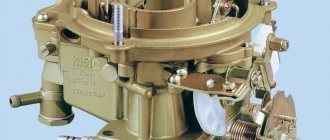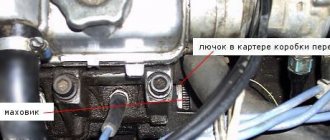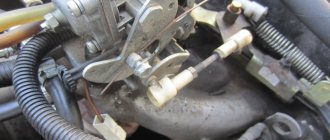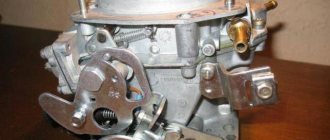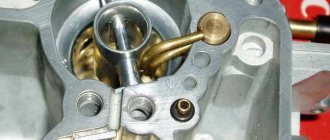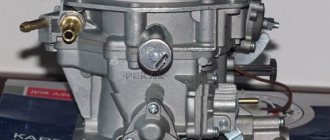How to adjust the idle speed system (IAC) of a Solex carburetor?
Problems with the operation of the idle system almost constantly haunt owners of cars whose engines have a Sodex carburetor installed. Either the idle speed disappears, or there is a failure when you press the gas pedal at idle, or the carburetor does not respond to adjusting the quality and quantity of the fuel mixture with screws.
The vast majority of these problems can be solved if you know what and how affects the normal operation of the Solex ACS and how you can ensure its uninterrupted operation.
Using the example of the 21083 carburetor idle system, which is installed on the 21083 engine of VAZ 21083, 21093, 21099 cars, we will try to independently configure and adjust the CXX.
High fuel consumption of VAZ 2108, 2109, 21099, 2105, 2107 cars
Let's consider the reasons for the high fuel consumption on VAZ 2108, 21081, 21083, 2109, 21093, 21099, 2105, 2107 cars and similar ones with carburetors 2108, 21081, 21083 Solex 2105, 2107 Ozone.
In this article we list those that are directly related to one or another carburetor malfunction. Other reasons not related to it are set out in the article “Causes of increased fuel consumption not related to the carburetor.” Indirect signs accompanying high fuel consumption are black carbon deposits on the spark plugs, pops or shots in the muffler, increased engine idle speed, black exhaust from the muffler, or exhaust with a persistent smell of gasoline, etc.
The page “Fuel consumption of VAZ cars with carburetor engines” provides examples of fuel consumption for various models of VAZ cars. Compare whether your consumption fits into the given standards. Perhaps the seemingly high fuel consumption actually falls within the standards set by the factory. If it doesn’t fit, then here is a list of possible reasons for this behavior of your car.
Reasons for high fuel consumption on VAZ 2108, 2109, 21099, 2105, 2107, etc.
— The carburetor air damper is not fully open
When a warm car engine is running, the air damper in the carburetor must be completely open and positioned strictly vertically. In this case, the “choke” handle must be recessed all the way. This applies to both carburetors 2105, 2107 “Ozone” and carburetors 2108 “Solex”.
Fully open air dampers of carburetors 2108, 21081, 21083 Solex, 2105, 2107 Ozone
If the air damper is not fully open, with the choke handle fully recessed, then there is a malfunction. In this case, the volume of air entering the fuel mixture decreases, and the proportion of gasoline increases. The fuel mixture enters the engine cylinders over-enriched, and fuel consumption increases.
Removal and installation of Solex. Solex tuning
According to the book instructions, the fuel level in the Solex 21083 carburetor is measured using a caliper; the distance between the upper surface of the main body and the level of fuel in the chamber is determined; it should be 24-26 mm. Thus, through simple manipulations that restored the functionality of these Solex carburetor systems, we achieved some increase in power and throttle response of the car engine without tuning or modifications, while maintaining its fuel appetite at normal levels.
Useful tips
Today there are many different models of carbs. All modifications have the ability to reduce fuel consumption, i.e., make the car more economical.
Here are a few basic things to know before undertaking flow reduction surgery.
- Each carburetor, even the simplest one, has a damper, a diffuser, a chamber with a float and jets.
- The chamber contains a float and a needle, which locks and unlocks the access of fuel inside.
- The float in the chamber floats up at the moment when the gasoline reaches a certain level. He presses on the needle, which blocks the access of fuel.
- The gasoline level decreases as the engine runs. The float stops pressing on the needle, it opens the fuel supply.
- The fuel nozzle is designed to supply fuel to the atomizer from the chamber. The volume of liquid supplied directly depends on the size, shape and cross-section of the nozzle.
- Jets are calculated depending on the volume of the vehicle’s power unit. For example, if this is a car with a 1.6 liter internal combustion engine, then you can purchase a repair kit for 1.3 liters. Thus, jets with a smaller cross-section are selected, since the volume of the 1.3-liter engine is smaller.
Note that the cost of repair kits to reduce fuel consumption of carburetor cars is lower for domestic models than for foreign cars.
Solex 21083 carburetor design
Solex-type carburetors began to be used on Russian (Soviet) cars from the mid-80s of the last century; at first they were installed on the VAZ-2108 car. The first carburetors were designed to work with engines of 1100 and 1300 cm³, and they were labeled DAAZ-2108. Later, the Solex 21083 model was developed, and the digital index means that the device is intended for installation on 1.5-liter VAZ-21083 engines.
The carburetor serves to prepare the fuel mixture on which the engine runs and ensures uninterrupted, stable operation of the power unit at any speed and load. Solex-21083 consists of the following main parts:
- the main body, which contains diffusers, the main dosing system (GDS), the idle system, the economizer and the accelerator pump;
- covers with an air damper, floats, a solenoid valve, and a cold internal combustion engine starting device.
The Solex carburetor is a two-chamber carburetor, the GDS fuel jets are located in the middle of the chambers in the very depths of the main body, and the GDS air jets are installed on top of them. The Solex 21083 carburetor is equipped with a heating unit for the air-fuel mixture, to which the cooling system hoses are connected. The throttle valves are located at the bottom of the main body and open sequentially; the opening of the valve in the second chamber is ensured by the drive levers.
There are two pipes in the cover - one of them is designed to supply fuel to the carburetor, the second is a return pipe and serves to return excess fuel to the gas tank; also, due to the “return”, the pressure in the fuel system is reduced.
Common faults
A well-maintained and properly tuned carb will not cause any problems to its owner. But often this does not happen. Elements break, and there are fewer and fewer carburetor specialists. Let's look at the main problems with these devices.
Most often, malfunctions occur with the accelerator pump. Its main function is to enrich the fuel mixture. During the operation of the car, as well as due to poor-quality fuel filters, the pump becomes clogged. As a result, dips appear and the car “does not move.” The situation can be corrected by disassembling and cleaning the carburetor (in particular, the accelerator pump).
Problems with idle speed also often occur. Usually the idle jet and solenoid valve are to blame. The EPHH unit also fails. The GDS jets also become clogged.
Where to begin
The accelerator pump provides the required amount of mixture during sharp acceleration, when the main metering system does not have time to provide this, since it provides normal supply only when the throttle is opened smoothly. At the stage of the engine control check, it is necessary, of course, to start it, and then for about thirty seconds observe the flow of fuel into the chambers from the small diffusers, using a small flashlight for a better view.
Setting up the power system
Reducing fuel consumption is a very relevant topic for many CS, including Solex. Owners of cars with such a carb know that one of the reasons for increased consumption is an incorrectly configured power system. You can diagnose this moment with your own hands. It will be enough to remove the cover of the VF (filter), and then carefully look at its position.
- If the damper is slightly open, then it already creates something like a shield above the diffuser. A change in vacuum affects the quality of the mixture. And many cars equipped with Solex carbs have problems with overconsumption in most cases for this reason.
- A clogged and dirty filter will affect the over-enrichment of the mixture, since the amount of air will flow in less. Accordingly, fuel consumption will increase. It is better to replace or clean such a VF.
Often, carburetor engineers bend and modernize the elements of the carb chamber in order to improve the power performance of the car. As a result, fuel flows only into the first chamber, which leads to an increase in fuel assembly consumption. In addition, a car reconfigured in this way will not behave smoothly on the road.
Installation of idle speed • Supply channels un
| Solex carburetor adjustment table Often, to improve the acceleration and dynamics of the car, some motorists install fuel nozzles of a larger cross-section, but it should be borne in mind that in this case fuel consumption can increase significantly, and experimenting with the installation does not always give the desired results. Dips that occur when you sharply press the gas pedal and disappear when the engine is running for 2-5 seconds in the same mode are caused by a malfunction of the accelerator pump. |
- weak compression in the cylinders;
- ignition is not adjusted;
- spark plugs do not work well;
- high-voltage wires are pierced.
Tips for saving fuel
You can actually save fuel
Many VAZ 21099 owners are interested in how to reduce fuel consumption. Here are some tips from the experts:
- Often, excessive consumption of gasoline occurs when compression in the engine cylinders is impaired or when it overheats. Measure the compression. If it is below 8.5, have the engine repaired. If the problem is overheating, drain the old antifreeze, flush the system, replace the coolant temperature and radiator fan sensors, and fill in with new antifreeze.
- Check tire pressure. The lower it is, the higher the consumption. Stick to the recommended values of 1.8 atmospheres for the front wheels and 2 atmospheres for the rear.
- If your car has air conditioning, consumption increases by 1 liter per 100 kilometers. There's nothing you can do - pay for comfort.
- Close the windows when driving on the highway; open windows at speeds above 70 km/h increase fuel consumption by 1-1.5 liters.
- Empty the trunk - it should contain a spare tire, tools, a tow rope, a warning triangle, a fire extinguisher and no more than 5 liters of technical fluids. The lighter the car, the less gasoline the car consumes.
- If you have a carburetor installed in your fuel supply system, check whether the brand of this device matches the type of engine installed on your car. When installing devices designed for 1.1 and 1.3 liter engines on more powerful engines, fuel consumption inevitably increases.
Follow these tips and remember: the less often you press the accelerator pedal to the floor, the fewer times you stop at the gas station.
Selection and modification of Solex carburetor jets
The selection and modification of jets on Solex carburetors is carried out in two cases: if it is necessary to increase the power indicators of the car engine (quick start, throttle response, increased speed) or to reduce the engine fuel consumption from the rated values. “Solex carburetor jets” is a table of jets that needs to be opened before starting their selection and modification. Before carrying out work, you must make sure that the carburetor and engine are operating normally with standard jets. It is also recommended that before modifying the carburetor, bring the vehicle’s power supply system and ignition system into proper condition. If the car engine consumes gasoline in buckets or triples or even doubles, it makes sense to carry out a full diagnosis of the engine systems, bring everything back to normal, and only then begin modifications. It should be remembered that when working with a carburetor, it is necessary to adhere to a certain pattern: an engine of a certain volume corresponds to a carburetor with a certain cross-section of diffusers, fuel and air jets of the main metering systems. A change in one or more components of this chain leads to a clear change in the operation of the engine. The increase or decrease in the throughput of the jets should be small and gradual - within hundredths of a millimeter. Therefore, for modification, it is better to purchase an additional set of fuel and air jets for the gas pumping station and perform all manipulations on them. We put the original jets back if the experiment fails.
Install air or fuel jets from another carburetor, from another engine
You can choose from the lists below.
Table of sizes and applicability of GDS fuel jets for Solex carburetors
| Carburetor models | 1st camera | 2nd camera |
| 2108-1107010 | 97,5 | 97,5 |
| 21081-1107010 | 95 | 97,5 |
| 21083-1107010 | 95 | 97,5 |
| 21073-1107010 | 107,5 | 117,5 |
| 21051-1107010 | 105 | 110 |
| 21083-1107010-31 | 95 | 100 |
| 21083-1107010-35 | 95 | 100 |
| 21083-1107010-62 | 80 | 100 |
| 21412 | 95 | 95 |
GDS fuel jet of the first chamber of the Solex carburetor 21083 Table of sizes and applicability of GDS air jets for Solex carburetors
Reasons for increased consumption
It is the reason for the increase in consumption that must be eliminated first. If you don’t do this and don’t know why gasoline consumption is increasing, the reduction will be ineffective. And you won’t have to interfere with the design of the carburetor if, for example, the consumption has increased due to clogging.
How to reduce gasoline costs
Quite often, fuel consumption is determined incorrectly due to the fault of the instruments taking readings. The error of the speedometer, sensors - all this can play a big role. Driving style is also of great importance, contributing to increased consumption. By the way, it is common to many young car enthusiasts. They pour 10 liters of gasoline into the fuel tank, set the daily counter to 0, drive with the engine warming up and stops in the city and on the highway, trying to cover the 120-kilometer journey. Agree that this is not only stupid, but also negatively affects consumption figures.
You should know that the most economical way is to drive the car on a flat road. The speed should be within 90 km/h, the highest gear is engaged - 4th or 5th, depending on the gearbox. In this state, only the first chamber of the carb is open. If you accelerate, gain speed above 100 km/h, the second chamber will open.
Solex 21083 carburetor design. Solex tuning
| Adjusting the VAZ-2109 carburetor: 5 signs of malfunction and 3 instructions Do not forget that constant adjustment of the carburetor, its proper cleaning and tuning will significantly extend the life of the device and avoid complex and expensive repairs. The carburetor serves to prepare the fuel mixture on which the engine runs and ensures uninterrupted, stable operation of the power unit at any speed and load. |
| Solex carburetor 21083: device, adjustment, setup | In general, full-fledged tuning of the Solex carburetor consists of increasing the elasticity of the power unit at medium and high speeds, while not forgetting to achieve full filling at the bottom. The carburetor system has a simple design and is quite reliable, but its main component, the carburetor, requires periodic adjustment. |
- Warm up the engine to 85-90°C.
- Press the choke lever all the way, it should be 100% open.
- Stop the engine and connect the tachometer. Before doing this, read the instructions for the device and follow them.
- Start the engine and turn on the high beams and heating - so that there is a load on the network.
Dismantling
Before setting up the VAZ-2109 carburetor with your own hands, you need to blow it out and rinse it. This process begins with dismantling the device. It's very easy to do. Simply turn off the ignition and remove the air filter housing. Then remove the spring that is installed on the air damper actuator.
After this, disconnect the throttle cable. The next step is to unscrew the fastening that holds the choke cable. All that remains is to unscrew the nuts that hold the device body in place. After this, you can completely remove the device.
Adjusting the Solex 21083 carburetor
The Solex carburetor has several types of adjustments, and you can adjust:
- gasoline level in the float chamber;
- number of minimum idle speeds;
- qualitative composition of the fuel mixture (FC) using the idle speed screw (IQ).
Adjusting the quality of the vehicle is very simple, and any car owner can do the adjustment with his own hands. To do this, you need to warm up the engine well and set the speed screw to 800-900 rpm. Then:
- tighten the quality screw until the internal combustion engine begins to operate with some interruptions and reduce the number of revolutions;
- We unscrew the screw so that the motor starts running smoothly again, usually one turn is enough. If the screw is loosened too much, fuel consumption will increase.
In other cases, you have to loosen the quantity screw more, since dips appear in the engine’s operation.
One of the most common idle problems is the inability to adjust the Solex 21083 carburetor using a quality screw - when it is tightened and unscrewed, the engine speed does not change. There are several reasons for this malfunction:
- the jet in the solenoid valve is clogged;
- the XX channel, which is located under the “quality” screw, is clogged;
- The solenoid valve (EC) itself is faulty.
It’s quite easy to check the functionality of the EC itself; we do it as follows:
- with the engine not running, remove the wire from the valve;
- unscrew the EC;
- we remove the fuel nozzle from it, it is pulled off by hand;
- turn on the ignition;
- We connect the wire to the EC - at the moment of contact, a dry, clear click should be heard, and the valve stem is recessed. If there is no click and the rod does not move, such an EC must be replaced.
It is also necessary to immediately blow out the nozzle - in some cases, such a small speck gets into it that it is practically invisible. There is also a problem with Solex - the idle channel under the quality screw becomes so clogged that it is impossible to clear it.
You can check the performance of the EC in another way - while the internal combustion engine is idling, you need to pull the wire from the solenoid valve - if the engine stalls, it means that the solenoid valve is working properly.
If the XX channels are clogged, the engine starts to work intermittently at minimum speeds and stalls when the gas is released. When you don’t have time to do repairs, but you need to get to your destination urgently, there is one way to make the engine run stably at idle. To do this, while the internal combustion engine is running at idle, we loosen it with a 13 EK key and find the position in which the engine operates most stably. But you shouldn’t drive like this all the time - with this position of the solenoid valve, fuel consumption increases sharply, since the idle system bypasses the XX fuel nozzle.
Operating principle
There is no point in examining in detail how a carburetor works, so let's study the basic principle of operation. A carburetor is a special device whose main task is to supply the engine with a fuel mixture in different operating modes.
When starting an internal combustion engine, many drivers open the air damper of the first chamber - this allows the mixture to be supplied to the cylinders as rich as possible. The engine should start. Then, as the engine warms up, the air damper is closed and the carburetor returns to its main operating mode.
The fuel mixture is supplied from the pump to the float chambers, which feed the first and second chambers. The gasoline level here is adjusted using a needle valve. Next, fuel is supplied from the chambers through special channels in the device body into the main jet and then into the first chamber. The mixture supply level is controlled by the accelerator pedal. The latter, in turn, regulates the throttle valve. The second camera will be activated if you press the gas pedal more than halfway.
When the engine is idling, the device does not use the main metering system. These carburetors have a separate idle design. Fuel and air are supplied through separate channels in the housing. XX jets are also present. Many owners have problems with setting the idle speed on VAZ-2109 carburetors.
How to adjust the carburetor on a VAZ 2109
If a malfunction of the device occurs, or during the cleaning process, defects in individual parts are discovered on the removed device, then you should think about replacing them. The locknut, which is located on the accelerator pump housing, should be loosened and the adjusting screw should be turned with a screwdriver until the required clearance is established;.
How to set the ignition angle?
Many people recommend using a strobe light for these purposes. But this is true for new cars. If the motor is already worn out, this angle set by the strobe will be incorrect. It is best to rely on the hearing and behavior of the car.
So, how do you set up the ignition yourself on a VAZ-2109? By the way, we have already examined the carburetor in full. The first step is to start and warm up the engine. Then you need to loosen the nuts holding the distributor and turn it in one direction or the other until the speed begins to increase and the engine starts running stably. Next, the nuts are tightened.
After this, you need to drive the car and look at its reaction. If the car “does not drive,” then the ignition is too early. Next, you need to accelerate to 50 kilometers per hour, engage fourth gear and press the accelerator pedal. If detonation sounds occur, then the ignition is set even later. If the detonation lasted a few seconds, then everything is in order. And if it is not there at all, then the ignition is too late.
It is recommended to set it again. But in this case, the ignition distributor should be rotated in the opposite direction. Please note: the slightest inaccuracy and an error of 1 degree are fraught with detonation. After successful setup, the car will begin to pick up speed normally and consume less fuel (but not below factory settings).
Back to the past! We remember about carburetors: how to drive, configure and repair
During periods of economic crises and financial problems, the service life of cars increases, the demand for something that was just recently squeamishly turned away from increases, the skills of repairing and maintaining old equipment in working order are forced to be remembered and mastered... What to do if you need a cheap auxiliary car, but The one that suits you in terms of money and condition has a carburetor engine, which almost no service center can fix now?
A carburetor is a specific part of a car. At one time he frightened many handy car owners and even professional mechanics (it was not for nothing that the carburetor mechanic was always a separate, narrow specialist and was respectfully called a “shaman”!), and even more so now, when sacred knowledge has been practically lost. Many remember their carburetor cars with a shudder - the constant floating of idle speed, special starting techniques, failures and jerks in movement, caused either by heat, or humidity, or the Moon in Capricorn... Although some were lucky, the injection era of the second half of the 90s years, let's be honest, everyone was greeted with relief.
However, even today, in the third decade of the 21st century, you can cross paths with a carburetor car. Not everyone and not always have sufficient free funds when the need arises for some kind of budget auxiliary machine - for country construction, hunting/fishing, or as a “jump car” to get to the garage where a decent car is parked... Yes You never know the tasks for which an old and inconspicuous car (usually domestic) would be useful, which you don’t mind throwing anywhere and scratching without grabbing your heart and wallet. But if, among the dead injection rot, a well-groomed “carb” car comes across, many, crossing themselves, quickly walk past...
Take the same “jump car” - look how the prices for Matiz are inflated - 200-300 thousand are now being asked for a copy with rusty sills! For four times less money you can buy an Oka in excellent condition. But 99% OK - with carburetor engines, and many are scared off by unstable starting, jumping idle, jerking during acceleration and other hemorrhoids, for which there is no one to really turn to in terms of repairs... Or here’s a classic of the genre for a lover of active car sex: Niva and UAZ vehicles, which may well turn up in the form of “time capsules” from grandfather’s dusty garages, are very likely to have “carb” engines.
The same applies, for example, to the VAZ 2109/08 – one of the most balanced and successful cars in the domestic automobile industry of all time. If such a car turns up inexpensively and with a intact body, you should take it, regardless of the carburetor. “Devyatos” with its rear beam that practically does not protrude from the bottom after lifting the suspension and installing tougher tires is a very crawlable and passable vehicle, capable of performing ¾ of the Niva’s tasks, except for completely off-road cases! And in general, in the end, in 2022, a carburetor car may turn out to be the first and main car for some time - anything can happen...
In principle, almost any engine for an old carburetor car can be bought in its injection form and simply change the engines. Or not even the whole thing, but just the intake. But this procedure is not five minutes and often not too cheap. Such movements made sense at the beginning of the injection era, when owners of cars from early years of production sought to join the latest engine developments. Or if you are a mechanic working in a car repair shop, and you have a lot of different hardware at prices “for your own” or even free. But when we are talking about an old and inexpensive car, an auxiliary or even the main one, then changing the engine to an injection one is just throwing away money, time and effort.
This is a completely useless idea, because:
- A well-functioning carburetor paired with contactless ignition starts in any frost no worse than an injector!
- A well-tuned carburetor on domestic cars gives exactly the same dynamics as on the same engines, which were later “injected” without changing the design of the engine as a whole!
- A tuned carburetor has similar (or even lower) fuel consumption than an injector on the same engine!
But the key word in all this is “MOUNTED”... However, in reality, a carburetor is a fairly simple thing to resuscitate and adjust. But not everyone knows about it! Yes, Kolesa.ru is still not a step-by-step repair manual, and we will not go into the design features and life hacks of all existing varieties of carburetors, which will require a very thick book. Considering that the basic systems on almost all carburetors are identical with minor differences, we will simply give an easy-to-understand general course of action that will clearly demonstrate that there is no need to be afraid of the carburetor.
And anyone who does not shy away from repairing a car with their own hands, without being a professional in this field, can bring this unit into ideal condition.
Is it worth starting all this?
If fate has connected you with a carburetor car in 2022, two logical and reasonable questions arise that lie on the surface. Maybe just buy a new carburetor and screw it on in a quarter of an hour instead of the old, buggy one?
Not forbidden. And carburetors for almost the entire Russian automobile industry are available today and are not in short supply. But the cost of a new carburetor is 5,000-6,000 rubles (for some, it’s just a trip to a cafe, and for others, even a third of their salary!), and the culture of their production is extremely low. The era has passed, and they are manufactured on long-worn equipment, with defects in casting and drilling, with channels clogged with chips and dust. Unfortunately, there is no guarantee that the new carburetor will not, due to fatal design defects, over-enrich the mixture or not keep idle... So it seems more rational to overhaul the old carburetor, which was already guaranteed to work in the past.
Second question: maybe use the services of a professional carburetor specialist and not get into such a complex unit yourself, without having any (or only a basic) understanding of its structure? Alas, you still have to roll up your sleeves. The fact is that not a single carburetor specialist will do what you need - a complete overhaul, cleaning and adjustment of the carburetor for its long and trouble-free operation. No one! And before, “shamans” (who are now, by the way, not so easy to find) never did this, and they won’t even today! Because otherwise they simply won’t earn money - nothing personal... Their field of activity is eliminating MINOR malfunctions of at least a living carburetor, when it is necessary to quickly deal with a local problem, cutting off 500-1000 rubles and sending the client home. Total disassembly of the carburetor in the format of a roadside express repair with soaking it for a day in a bucket of acetone - how do you imagine that?! Such a service was once offered only by carburetor factories that engaged in complete restoration repairs, and by carburetor shop foremen at large motor transport enterprises. In the Soviet and early Russian years, private car owners could come to the plant, hand over their carb and receive a rebuilt carb with a guarantee - washed, after replacing all wear parts and with a guarantee. But today such services are very rare, and this can only be done efficiently with your own hands.

